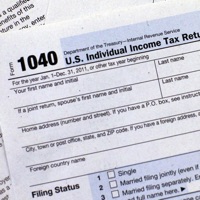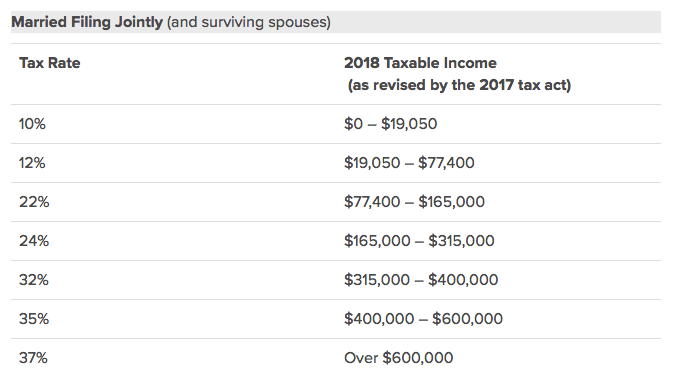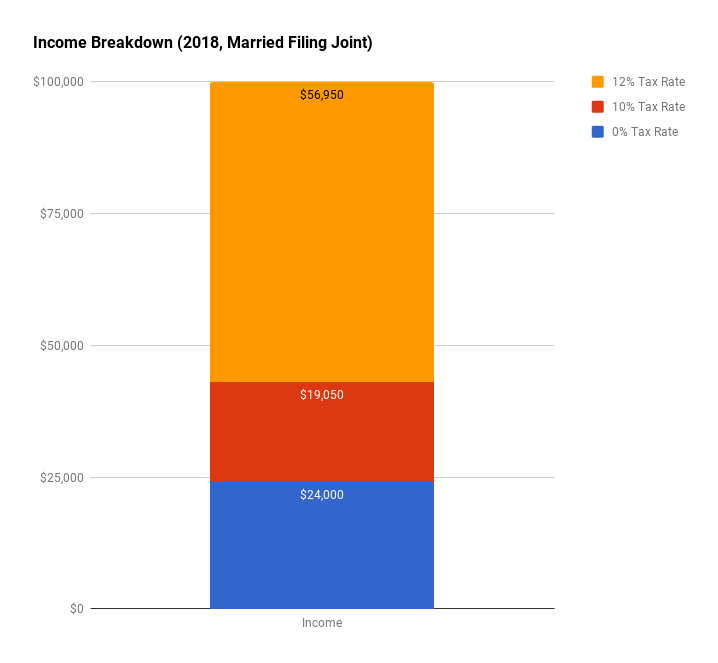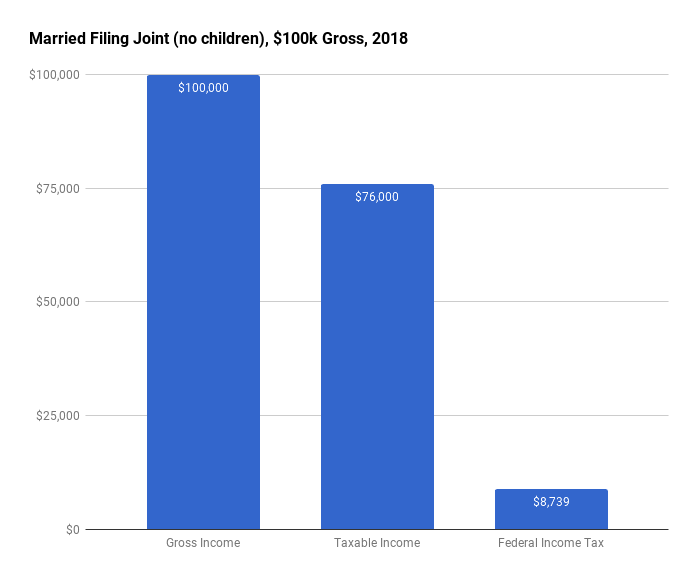 The Tax Cuts and Jobs Act (TCJA) changed up the personal income tax brackets, exemptions, and deductions. Here is an updated graphical breakdown of a simple scenario for a married filing joint couple with no children in Tax Year 2018. I’ll also try to illustrate the relationship between gross income, taxable income, marginal tax rate, and effective tax rates. See also:
The Tax Cuts and Jobs Act (TCJA) changed up the personal income tax brackets, exemptions, and deductions. Here is an updated graphical breakdown of a simple scenario for a married filing joint couple with no children in Tax Year 2018. I’ll also try to illustrate the relationship between gross income, taxable income, marginal tax rate, and effective tax rates. See also:
- 2018 Income Tax Brackets Example (Single No Kids)
- 2018 Income Tax Brackets Example (Married w/ 1 Child)
2018 federal income tax rates for married joint filers. Taken from the official IRS tax tables (source):

The following changes also apply for Tax Year 2018:
- The personal exemption deduction is now gone ($0), from $4,050 in 2017.
- The standard deduction for single taxpayers and married taxpayers filing separately rises to $12,000 from $6,350.
- The standard deduction for married taxpayers filing joint returns rises to $24,000 from $12,700.
- The standard deduction for heads of household rises to $18,000 from $9,350.
- The Child Tax Credit was expanded with higher income phaseout limits and is now worth up to $2,000 per qualifying child.
Let’s say your household combined gross income is $100,000 a year. You are a married couple with no children, and both earn $50,000 gross income. You are both employees that receive W-2 income only (i.e. neither are self-employed). You don’t have any additional income sources like interest, capital gains, rents, etc. You don’t have any deductions like IRA/401k contributions or mortgage interest that will allow you to itemize deductions. We will ignore any state or local income taxes.
Gross income. Let’s start with your annual $100,000 gross household income. There are no personal exemptions. Instead, you get the larger standard deduction which is $24,000 for married joint filers in 2018. Since you don’t have a lot of itemized deductions, you fall back onto the standard deduction.

The first 24,000 of your gross income is not taxable. Without doing anything special at all, your $100,000 in gross income is now only $76,000 in taxable income after personal exemptions and the standard deductions.
The first $19,050 of taxable income is subject to a 10% tax rate. Shave off 10% of $19,050 and put that on your tax bill ($1,905). The remaining $56,950 of taxable income is moved onto the next tax bracket.
The next $58,350 in taxable income is subject to a 12% tax rate. However, we only have $56,950 left. So we shave off 12% of $56,950 ($6,834) and add that to the existing $1,905. The total tax bill is now $8,739.
In this example, this 12% is your marginal tax bracket. If you earned another $1, it would be taxed at this marginal rate of 12%. Even with a six-figure income, a married couple can still land in the 12% marginal tax bracket (pre-tax 401k or IRA contributions would reduce taxable income even more).
(Have kids? See this example for married with children.)

Payroll taxes. These aren’t technically federal income taxes, but you must each pay a Social Security tax (OASDI) of 6.2% and Medicare payroll tax (HI) of 1.45% of your gross income. That’s $3,100 a year for Social Security and $725 a year for Medicare. You both earn $50,000 gross and don’t exceed the income caps. (Your respective employers pay the same amount.)
Overall effective tax rate. You paid $8,739 in federal income taxes on $100,000 of gross income, for an overall effective tax rate of 8.7%. You also paid 7.65% in payroll taxes.
For comparison, the same married couple with no kids in 2017 would have paid $11,278 in federal income taxes on $100,000 of gross income, for an overall effective tax rate of 11.3%. Payroll taxes would be the same.
 The Best Credit Card Bonus Offers – 2025
The Best Credit Card Bonus Offers – 2025 Big List of Free Stocks from Brokerage Apps
Big List of Free Stocks from Brokerage Apps Best Interest Rates on Cash - 2025
Best Interest Rates on Cash - 2025 Free Credit Scores x 3 + Free Credit Monitoring
Free Credit Scores x 3 + Free Credit Monitoring Best No Fee 0% APR Balance Transfer Offers
Best No Fee 0% APR Balance Transfer Offers Little-Known Cellular Data Plans That Can Save Big Money
Little-Known Cellular Data Plans That Can Save Big Money How To Haggle Your Cable or Direct TV Bill
How To Haggle Your Cable or Direct TV Bill Big List of Free Consumer Data Reports (Credit, Rent, Work)
Big List of Free Consumer Data Reports (Credit, Rent, Work)
This would be our filing status. I did a “quick and dirty” dry run earlier this year using the data from our 2017 return and applying the new rules. To my surprise, we would have saved some — a small amount — on last year’s return under the new rules. I say that because I have been a been uncertain about this, as my wife and I have a lot of itemized deductions. We give a pretty good chunk to charity — as well as home mortgage/equity line interest, property taxes, state income taxes, etc. I think a lot people don’t realize that the increase in the standard deduction comes with the loss of the personal exemptions. So for those who previously itemized but may now just take the standard deduction, the benefit may not as great as it is for the majority of taxpayers.
Are you planing to use a software, like Turbotax to help with ins and outs ? We have a change in the family, so I’m looking for an advice.